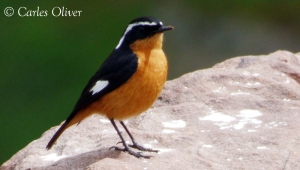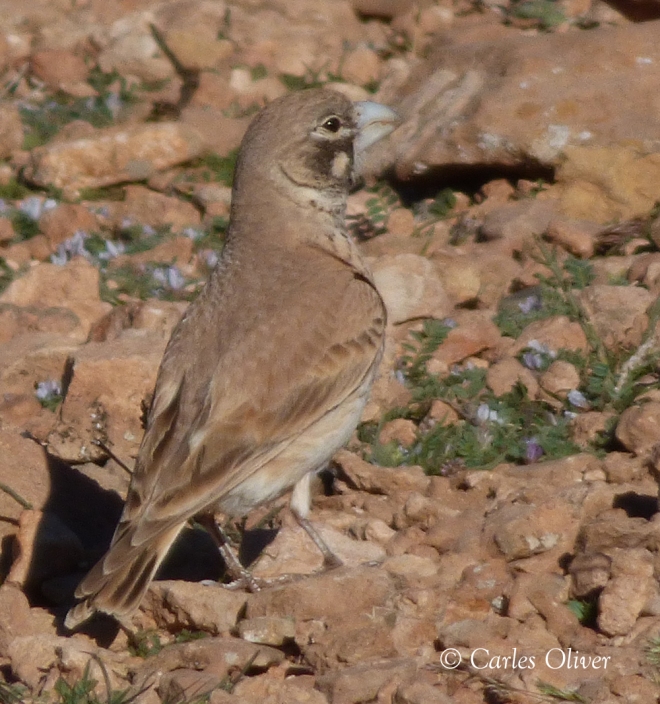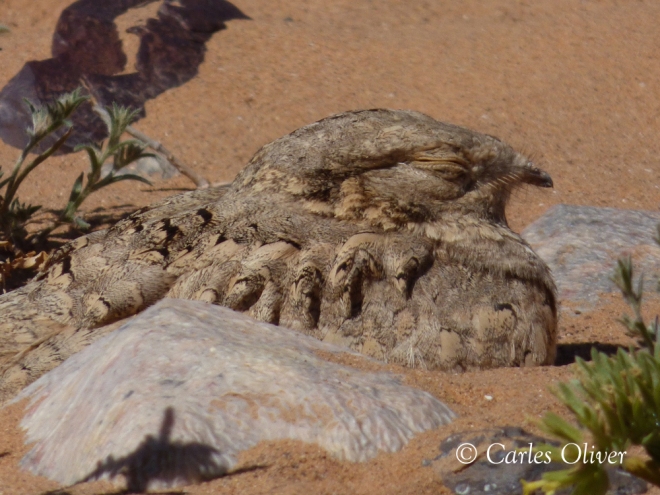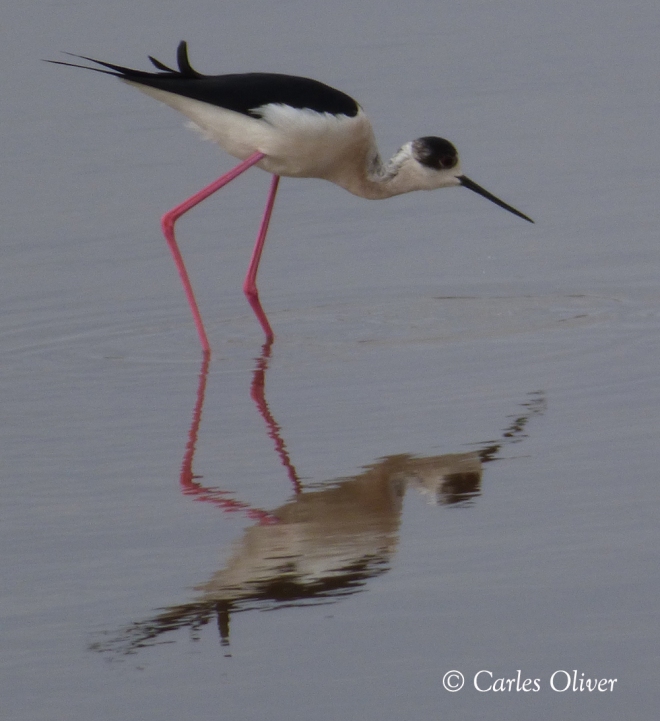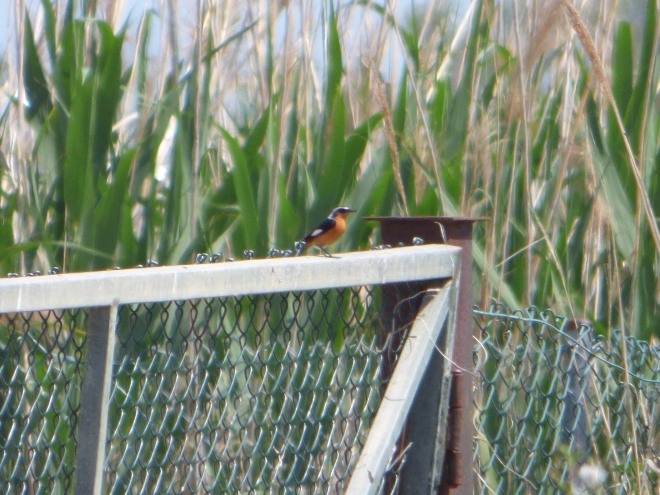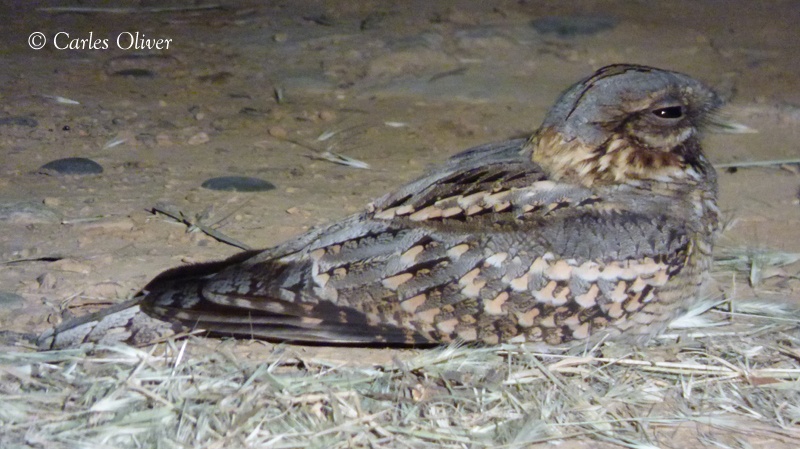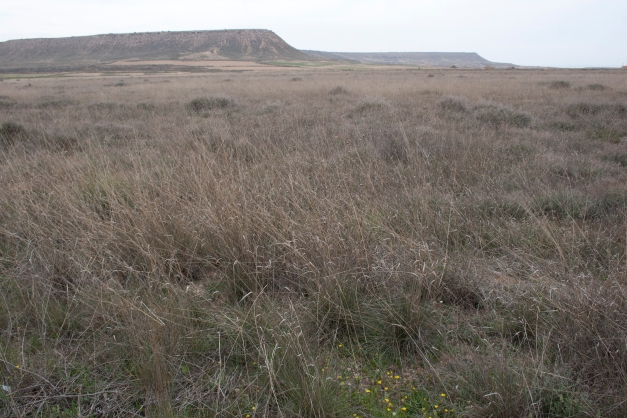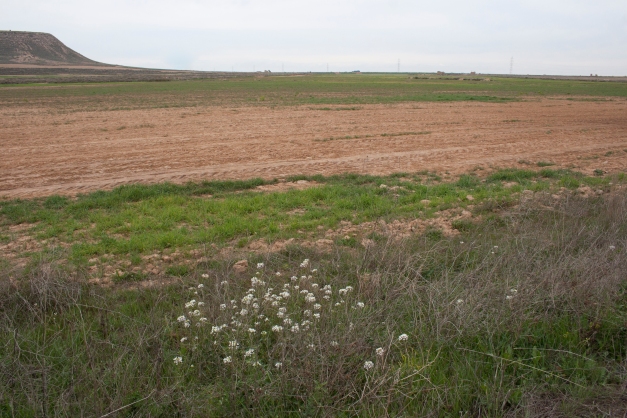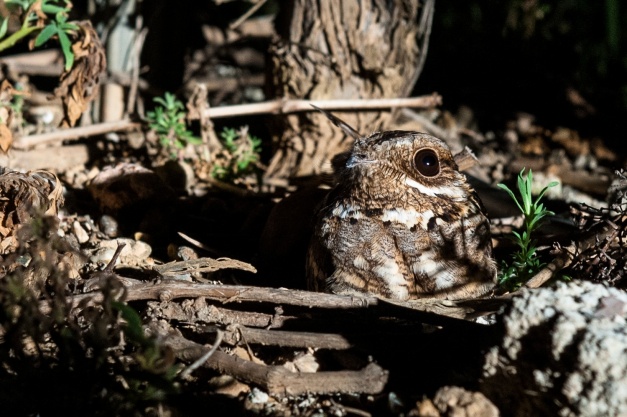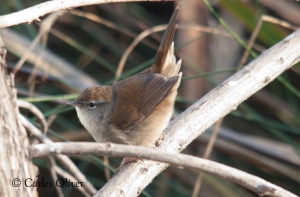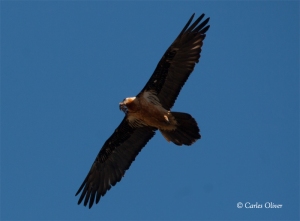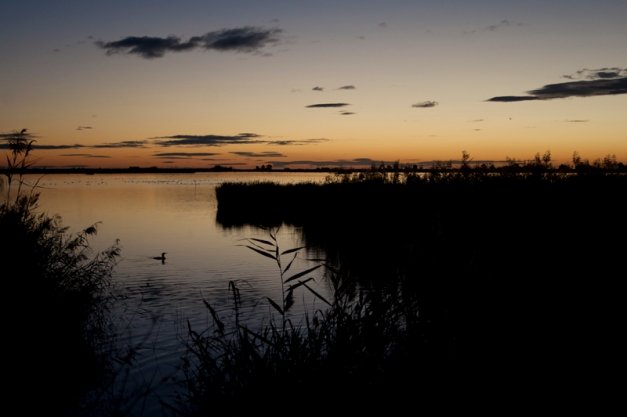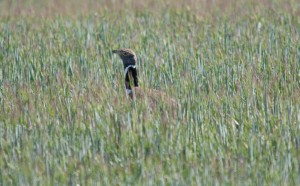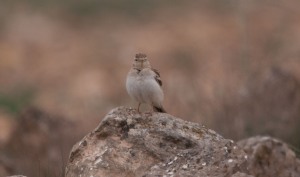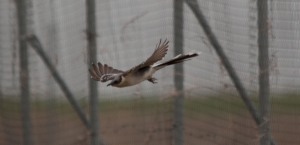- Dates: From February 6th to 10th, 2024
- Tour participants: 5
- Number of species seen: 110
- Tour leader: Carles Oliver
All images in this trip report by tour leader Carles Oliver unless otherwise specified. All rights reserved.
Overview: 10th Pyrenees Winter Break issue. This winter in the Pyrenees has been specially unnormal. The winter started normally, with the first snowfall happening in early November. Soon, the trend changed and we faced several weeks without any snowfall and the high temperatures melted the few snow left. With temperatures ranking 25ºC in January, some high mountain specialties changed their normal routines, especially affected were Snow Finches and Citril Finches, but also Alpine Choughs. This anormal situation, made the tour a bit harder than usual. Despite all of this, we got excellent views in the high mountain specialties and many of the steppe birds, with stunning views on both Wallcreeper and Dupont’s Lark, and 8+ Lammergeiers & 5+ Cinereous Vultures seen.
Day 1. After gathering all the tour participants from their accommodations around the city and enjoy tea & coffee stop we headed to the first birding stop of the tour. During the next hour, we walked around a mosaic landscape with some large trees, bushland and crops.
Here we were delighted to see the first Iberian Green Woodpeckers of the trip, quite active in the early morning. The morning was a bit cloudy and, once again, warm for what we can expect in Barcelona in early February. Small flocks of Common Chaffinches were getting out of the fields, and along with them we saw European Serins and Eurasian Tree Sparrows. Our walk around had a nice start, with a showy Lesser Spotted Woodpecker was calling and drumming from the top of the canopies, and we had really good looks on it for almost five minutes. In this same spot we also got Iberian Green Woodpeckers and a Ring-necked Parakeet exploring some nesting holes. Both Great & Blue Tits were active in the area, and a juvenile Peregrine Falcon did a couple of fast flights in the area, hoping to catch one of the several small birds moving. Other interesting birds here included Eurasian Hoopoe, Eurasian Jay and Common Pheasant. 3 Rock Buntings flew out from the bushes, but unfortunately none of the tour participants had a proper view on them
From the lovely plain in the Llobregat Delta we drove to a small garden around Barcelona where a White-throated Sparrow had been seen. We waited for almost one hour but, unfortunately, the Sparrow didn’t show for us. Still, a nice flock of Red-billed Leiothrix was a great entertainment for us, with some Eurasian Blackcaps and Coal Tits also showing well.
After a short stop for coffees and logistics, we drove up to the hills, with the next stop in the top of the one of the highest mountains between Barcelona and the Pyrenees. Here we had the longest walk of the trip, aiming to connect with the small population of Alpine Accentors living there. Fortunately we didn’t have to walk a lot before a lovely flock of at least 12 Alpine Accentors came to us to offer the group wonderful and very long views, with some of the birds performing right in front of us for several minutes! It was midday and in this small peak, normally covered with snow in early February, the sensation was of being late September! We had a comfortable 15ºC when being at 1700m above the sea level! Even in such a conditions, it was very surprising to find a female Hen Harrier hunting in the slopes of the mountains, and moreover, to see 3 Dartford Warblers singing and chasing each other in the tall vegetation. This is only a summer visitor to this habitat, normally covered by snow. Dartford Warblers spend the winter at lower altitudes, waiting for the snow to melt and temperatures to arise up (this is normally happening by late March or early April).

From here we covered the short distance of driving to the first hillsides of the Pyrenees where, even before arriving to the planned stop, we had to do a stop in one of its minor roads, that appeared covered by hundreds of Finches. Here we got the first excellent views on Common Crossbill, with some superb males singing from the top of the Mountain Pines. Hundreds of Eurasian Siskins were calling and singing here, probably moving North to their nesting grounds in Northern Europe. Eurasian Goldfinch, Coal & Crested Tits, Goldcrest and Mistle Thrush were all seen here, some of them providing great looks. At least 2 Citril Finches were noted inside this massive flock of birds, but they flew over almost unnoticed and I fell to put anyone in the group on the Finches, that fastly disappeared in the forest.
The afternoon was well advanced when we had our last stop of the day. This time to have some time in a lovely subboreal forest. Here, we were again surrounded by Common Crossbills and Siskins and only one minute after leaving the van we had a Black Woodpecker calling not far away. It took us only a pair of minutes to contact with the bird, that was active with a variety of calls to finally stop in a large, dead trunk. There we enjoyed long views as the bird was first calling and then preening before going away. We still had some more time in this lovely habitat, but it didn’t produce anything else out of a pair of showy Great Spotted Woodpeckers and 1 Eurasian Nuthatch.





Day 2. After enjoying our breakfast in our quiet accommodation in La Cerdanya valley, we spent the next couple of hours exploring the valley immediately beside. Here, a number of selected stops produced a good list of birds that included large numbers of Mistle Thrushes and Redwings with some Fieldfares but also really good views on Short-toed Treecreeper, Common Crossbills, Crested Tit and, especially, gorgeous looks on Rock Buntings that seemed very active and ready to start the nesting season.
From here, we drove inside Andorra. All the main mountain passes in this area of Catalonia had no snow at the moment, and our only hope to find Snow Finches was to go inside Andorra and do some stops along a mountain pass reaching 2500 metres above the sea level and sky resort located nearby. Once there, we saw that the amount of snow was also really thin, and the sunny weather reduced our chances to connect with the Finches even thinner. Still, we enjoyed very lovely views on Alpine Choughs as they were feeding around the sky resort but also acting almost as Wallcreepers in the buildings around!
Crossing Andorra, we headed South towards the most impressive spot for large raptors in the Pyrenees. Even if the intense Andorran traffic made us go slowly, we arrived to the hillsides around Isona with the sun well high in the sky. Moreover, in our way out of Andorra we got excellent views on White-throated Dippers.
The rest of the afternoon we drove along a pair of tracks, with several stops to enjoy the many birds of prey in the sky. After three hours, a conservative count showed out 7 Lammergeiers, hundreds of Eurasian Griffons and 12 Cinereous Vultures. We got several excellent views, with adult Lammergeiers passing only tens of metres away from the van; Lammergeiers circling along with Cinereous Vultures; or a flock of 15 Griffons and 4 Lammergeiers all circling together to name some of most celebrated sights. Due to the multiple stops to enjoy the several raptors in the sky, we arrived to our accommodation a bit later than expected, but with some unforgettable memories!






Day 3. After breakfast, we covered the short distance from Lleida to the first gorges in the Pyrenees. Once there, we spent a couple of hours enjoying the rocky outcrops. Blue Rock Thrush had a short appearance, but Firecrests and Goldcrest gave us long views. In the cliffs, Griffons Vultures were nesting along with Rock Sparrows. In the river along the gorge, Dippers were moving up and down along with Grey Wagtails. Other birds here included Eurasian Sparrowhawk, Cirl Buntings and Sardinian Warbler.
But the main reason to come was another, and a really important one. To be fair, the Wallcreeper overwintering in the gorge didn’t take long to appear, but we had to wait a bit before everybody in the group could connect with it. Still, we were really lucky, and a Wallcreeper appeared at its typical place a bit after 10:00 in the morning. The bird was half way up in the cliff, and not very showy. We had to wait for 5 minutes before the bird, suddenly, decided to come down by the tarmac! The next 10 minutes were some of the most intense in our Pyrenean outings this winter, with extremely close views on this Wallcreeper, while the bird was moving really low along the gorge. At times, we had ti sensation of be able even of touching the bird!


After enjoying such a wonderful views on the one of the main specialties living in the mountains we drove down to the plains. There, large flocks of European Golden Plovers and Northern Lapwings were waiting for us. We have our lunch stop by a small pond, where we had Northern Shovelers, Common Pochards, Little Grebes, Eurasian Coots & Teals, 2 Green Sandpipers but also large flocks of White Storks in the move from their roosting places around Lleida. The area was also good for small birds and European Stonechat, Meadow Pipit, Eurasian Skylark, Crested Lark, Chiffchaff, Linnet, Reed Bunting and Eurasian Tree Sparrow were noted.
After lunch we changed to a second pond, and our visit was granted with nice views on 7 Ferruginous Ducks, a very scarce bird in Catalonia!
Driving East, we arrived to an area with a very different landscape. Here, small but cleverly managed fields still allow a good density of Little Bustards. This species, formerly fairly common in Iberia, had become almost a scarcity, and its winter flocks have been severely decimated. A first stop was done to try to connect with a pair of Black-winged Kites nesting in the area, but we only got a small flock of Woodlarks, several Corn Buntings and multiple views on Red Kite & Marsh Harrier. A bit further, 4 Little Bustards were seen by the road, and we got good views from the van to don’t disturb the birds.
The last stop of the day was deserved to the desert-like ambients South of Lleida, where we had a short walk to enjoy the first Thekla’s Larks of the trip along with lovely flocks of Red-billed Choughs, Spotless Starlings, Rock Sparrows and a Black Wheatear that refused to show for the group! It was already quite late, but we decided to have a very last stop, and our effort was very worth. We still had to get out of the van when we listened and Eurasian Eagle Owl calling from somewhere in the valley. After a fast scanning, we decided to go for a slow short walk, and after a few metres Mark got the bird singing from a dead branch up in the hillside. During the few minutes, we got amazing scope views on the bird while some Redwings were attending their roosting site. A superb way to end another very good day!



Day 4. After a sunny start of the trip, this was a grey and rainy day. A difficult weather to search for the specialties living in the steppes. Still, we went to explore the endless plains in central Monegros. A first stop in a small salty lagoon produced the only Kentish Plover of the trip along with Common Shelducks and Black-headed Gulls. From here, we got in the plains, but the muddy tracks made difficult for us to arrive to some locations. Still, we were lucky enough to contact with 2 nice Black-bellied Sandgrouses that provided flying views. 1 Little Owl was also a nice sight while flocks of Calandra & Skylarks were flying over the fields. After a couple of hours checking around the rain became heavier, and we decided to go for a service stop. It was a fortunate choice since the sky cleared right when we were leaving the coffee shop.
Back to the plains, we managed to arrive to a nice spot and soon we found a nice of 11 Pin-tailed Sandgrouses that stayed on a field for us for about 20 minutes. Here we had nice scope views with some good photo and video chances. Several Calandra & Crested Larks were singing here, and as the sun became stronger, the first Mediterranean Short-toed Larks (aka Lesser Short-toed Larks) of the trip were noted. From here we moved into a different section of the plains, and we were lucky to find a nice flock of 31 Common Cranes feeding on the ground at close range, and a closer flock of Eurasian Griffons on the ground, waiting for the weather to improve. Here we also got a nice male Hen Harrier flying over the large fields, and 2 extra Little Owls! But unfortunately the rain started again, even heavier than before and we decided to move away, trying to put some distance from the mud and the rain.
But when we arrive to our new accommodation, the rain was also there for us, and we decided to end the day after enjoying a distant view on a new Little Owl.

Day 5. After enjoying breakfast, we headed out to the large steppes immediatly South of Zaragoza. This is a wonderful are to enjoy steppe birds, with multiple places where to go and try to find the different specialties living in the region. After the generous rain of the previous day, we woke up in a sunny day with only some clouds.
We started driving in the minor tracks crossing the steppes and soon got 2 Black-bellied Sandgrouses in a farming area. Beyond, both Calandra and Mediterranean Short-toed Larks started singing, offering both really good looks. It didn’t take long before we got a first Dupont’s Lark singing. It looked like far away, but then a second bird started singing a bit closer. Some Short-toed Larks were around, feeding and providing some photo opportunities. The wind started to pick up, but both Dupont’s Larks were still singing. We put out the scopes, trying to see them in the ocean of grass in front of us, but we couldn’t contact with the bird..
After 40 minutes of scan we decided to move away and try a different spot. By that time the wind was already strong. A new Lesser Short-toed Lark in good light was welcome by the photographers in the group, but suddenly a second bird appeared right behind the Short-toed Lark. A Dupont’s Lark sitting in the top of a small bush only 10 metres away from us!! Soon we were all having the bird and celebrating our luck.



Leaving the steppes, we still had a pair of Red-billed Choughs displaying around and 2 Black-bellied Sandgrouses plus a pair of superb Golden Eagles in the highway. But certainly the wind had picked up in the last minutes. We started the final transfer to Barcelona, having a stop in a lovely lagoon with a wonderful reedbed. Unfortunately, by the time we arrived to the lagoon the wind was so strong that it was almost not possible to stand up, and we had to search refuge in a blind and even inside the van to enjoy our packed lunches. Here, we only got Gadwalls and Great Crested Grebes and the very strong wind made no possible to contact with any passerine living in the reeds.
Despite the strong wind, we still had something to add to our list and a small detour to explore a sheltered gorge produced a nice male Black Wheatear in the top of a small cliff, providing good views to all the members of the group. This very last minute sight was really appreciated, since the first contact with this species, a couple of days before, was poor and not everyone in the group actually so the bird.
After this short stop, we just transferred back to Barcelona to end our tour around the airport by mid afternoon.
List of birds seen during the tour
- Red-legged Partridge (Alectoris rufa)
- Ring-necked Pheasant (Phaisanus colchinus)
- Common Shelduck (Tadorna tadorna)
- Mallard (Anas platyrhynchos)
- Gadwall (Anas strepera)
- Eurasian Teal (Anas crecca)
- Northern Shoveler (Spatula clypeata)
- Common Pochard (Aythya ferina)
- Ferruginous Duck (Aythya nyroca)
- Little Bustard (Tetrax tetrax)
- Black-bellied Sandgrouse (Pterocles orientalis)
- Pin-tailed Sandgrouse (Pterocles alchata)
- Feral Pigeon (Columba livia domestica)
- Stock Dove (Columba oenas)
- Common Woodpigeon (Columba palumbus)
- Eurasian Collared Dove (Streptopelia decaocto)
- Eurasian Moorhen (Gallinula chloropus)
- Eurasian Coot (Fulica atra)
- Common Crane (Grus grus)
- Great Crested Grebe (Podiceps cristatus)
- Little Grebe (Tachybaptus ruficollis)
- Kentish Plover (Charadrius alexandrinus)
- European Golden Plover (Pluvialis apricaria)
- Northern Lapwing (Vanellus vanellus)
- Greenshank (Tringa nebularia)
- Green Sandpiper (Tringa ochropus)
- Yellow-legged Gull (Larus michahellis)
- White Stork (Ciconia ciconia)
- Great Cormorant (Phalacrocorax carbo)
- Western Cattle Egret (Bubulcus ibis)
- Great White Egret (Ardea alba)
- Grey Heron (Ardea cinerea)
- Lammergeier (Gypaetus barbatus)
- Eurasian Griffon (Gyps fulvus)
- Cinereous Vulture (Aegypius monachus)
- Red Kite (Milvus milvus)
- Hen Harrier (CIrcus cyaneus)
- Western Marsh Harrier (Circus aeruginosus)
- Eurasian Sparrowhawk (Accipiter nisus)
- Common Buzzard (Buteo buteo)
- Eurasian Eagle Owl (Bubo bubo)
- Little Owl (Athene noctua)
- Eurasian Hoopoe (Upupa epops)
- Great Spotted Woodpecker (Dendrocopos major)
- Lesser Spotted Woodpecker (Dryobates minor)
- Iberian Green Woodpecker (Picus sharpei)
- Black Woodpecker (Dryocopus martius)
- Eurasian Kestrel (Falco tinnunculus)
- Peregrine Falcon (Falco peregrinus)
- Rose-ringed Parakeet (Psittacula krameri)
- Mediterranean Short-toed Lark (Alaudala rufescens)
- Eurasian Skylark (Alauda arvensis)
- Crested Lark (Galerida cristata)
- Thekla’s Lark (Galerida theklae)
- Woodlark (Lullula arborea)
- Calandra Lark (Melanocorypha calandra)
- Dupont’s Lark (Chersophilus duponti)
- Meadow Pipit (Anthus pratensis)
- White Wagtail (Motacilla alba)
- Grey Wagtail (Motacilla cinerea)
- White-bellied Dipper (Cinclus cinclus)
- Alpine Accentor (Prunella collaris)
- European Robin (Erithacus rubecula)
- Black Redstart (Phoenicurus ochruros)
- Black Wheatear (Oenanthe leucura)
- European Stonechat (Saxicola rubicola)
- Song Thrush (Turdus philomelos)
- Redwing (Turdus iliacus)
- Mistle Thrush (Turdus viscivorus)
- European Blackbird (Turdus merula)
- Blue Rock Thrush (Monticola solitarius)
- Eurasian Blackcap (Sylvia atricapilla)
- Sardinian Warbler (Curruca melanocephala)
- Dartford Warbler (Curruca undata)
- Cetti’s Warbler (Cettia cetti)
- Common Chiffchaff (Phylloscopus collybita)
- Goldcrest (Regulus regulus)
- Firecrest (Regulus ignicapillus)
- Eurasian Wren (Troglodytes troglodytes)
- Eurasian Blue Tit (Cyanistes caeruleus)
- European Crested Tit (Lophophanes cristatus)
- Great Tit (Parus majors)
- Coal Tit (Periparus ater)
- Long-tailed Tit (Aegithalos caudatus)
- Red-billed Leiothrix (Leiothrix lutea)
- Short-toed Treecreeper (Certhia brachydactyla)
- Wallcreeper (Tichodroma muraria)
- Iberian Grey Shrike (Lanius meridionalis)
- Eurasian Magpie (Pica pica)
- Eurasian Jay (Garrulus glandarius)
- Western Jackdaw (Coloeus monedula)
- Carrion Crow (Corvus corone)
- Common Raven (Corvus corax)
- Alpine Chough (Pyrrhocorax graculus)
- Red-billed Chough (Pyrrhocorax pyrrhocorax)
- European Starling (Sturnus unicolor)
- Spotless Starling (Sturnus vulgaris)
- Eurasian Tree Sparrow (Passer montanus)
- House Sparrow (Passer domesticus)
- Common Rock Sparrow (Petronia petronia)
- Common Chaffinch (Fringilla coelebs)
- European Serin (Serinus serinus)
- Eurasian Goldfinch (Carduelis carduelis)
- Eurasian Greenfinch (Chloris chloris)
- Eurasian Siskin (Spinus spinus)
- Linnet (Acanthis cannabina)
- Common Crossbill (Loxia curvirostra)
- Cirl Bunting (Emberiza cirlus)
- Rock Bunting (Emberiza cia)
- Corn Bunting (Emberiza calandra)
List of mammals seen during the tour
- European Rabbit (Oryctolagus cuniculus)
- Red Fox (Vulpes vulpes)
- Red Deer (Cervus elaphus)










